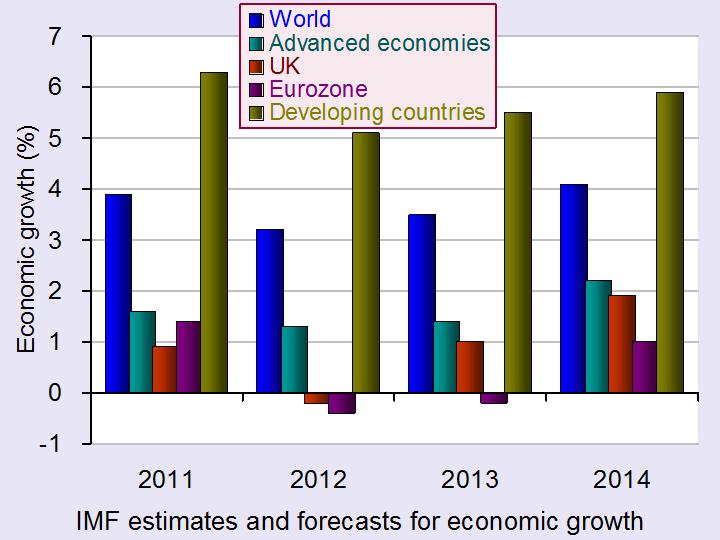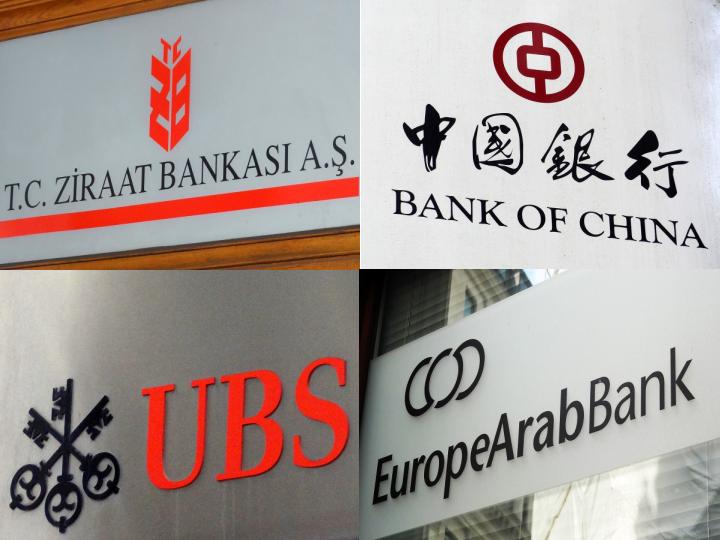 According to the first estimate by the Office for National Statistics, the UK economy shrank by 0.3% in the final three months of 2012. This means that over the whole year growth was flat.
According to the first estimate by the Office for National Statistics, the UK economy shrank by 0.3% in the final three months of 2012. This means that over the whole year growth was flat.
The biggest contributor to the fall in GDP in Q4 was the production industries, which include manufacturing. Output of the production sector fell by 1.8% in Q4. Construction sector output, by contrast, was estimated to have increased by 0.3%. Service sector output was flat. The chart below shows quarterly and annual growth in the UK from 2007 to 2012. (Click here for a PowerPoint.)
Latest estimates by the IMF are that the UK economy will grow by 1.0% in 2013 – well below the long-term growth in potential output (see also the last blog, High hopes in the Alps). But some forecasters are predicting that real GDP will continue to fall for at least one more quarter, which means that the economy would then be in a ‘triple-dip recession’.
 Not surprisingly politicians have interpreted the statistics very differently, as have economists. The government, while recognising that the UK faces a ‘very difficult economic situation’, argues that now is not the time to change course and that by continuing with policies to reduce the deficit the economy will be placed on a firmer footing for sustained long-term growth
Not surprisingly politicians have interpreted the statistics very differently, as have economists. The government, while recognising that the UK faces a ‘very difficult economic situation’, argues that now is not the time to change course and that by continuing with policies to reduce the deficit the economy will be placed on a firmer footing for sustained long-term growth
The opposition claims that the latest figures prove that the government’s policies are not working and that continuing attempts to bear down on the deficit are depressing aggregate demand and thereby keeping the economy depressed.
The following webcasts, podcasts and articles expand on these arguments. Try to be dispassionate in using economic analysis and evidence to assess the arguments.
Webcasts and podcasts
 Video Summary: Gross Domestic Product Preliminary Estimate, Q4 2012 Media Briefing (Click here for the following Q&A) ONS (25/1/13)
Video Summary: Gross Domestic Product Preliminary Estimate, Q4 2012 Media Briefing (Click here for the following Q&A) ONS (25/1/13)
 Triple dip on the menu? Channel 4 News, Siobhan Kennedy and Faisal Islam (25/1/13)
Triple dip on the menu? Channel 4 News, Siobhan Kennedy and Faisal Islam (25/1/13)
 Getting and spending – the key to recovery Channel 4 News, Cathy Newman (25/1/13)
Getting and spending – the key to recovery Channel 4 News, Cathy Newman (25/1/13)
 UK economy shrinks by 0.3% in the last three months of 2012 BBC News, Hugh Pym (25/1/13)
UK economy shrinks by 0.3% in the last three months of 2012 BBC News, Hugh Pym (25/1/13)
 Danny Alexander on GDP figures and economic plans BBC Daily Politics (25/1/13)
Danny Alexander on GDP figures and economic plans BBC Daily Politics (25/1/13)
 Osborne defends government’s deficit reduction plan BBC News (25/1/13)
Osborne defends government’s deficit reduction plan BBC News (25/1/13)
 Ed Balls: UK economy urgently needs a ‘Plan B’ BBC News (25/1/13)
Ed Balls: UK economy urgently needs a ‘Plan B’ BBC News (25/1/13)
 UK heads for triple dip as GDP contracts 0.3pc The Telegraph, Philip Aldrick (25/1/13)
UK heads for triple dip as GDP contracts 0.3pc The Telegraph, Philip Aldrick (25/1/13)
 Economist: Government may need to rethink its fiscal policy The Telegraph, Jim O’Neill (25/1/13)
Economist: Government may need to rethink its fiscal policy The Telegraph, Jim O’Neill (25/1/13)
 Has austerity really been tried in Britain? BBC Today Programme, Jonathan Portes and Andrew Lilico (29/1/13)
Has austerity really been tried in Britain? BBC Today Programme, Jonathan Portes and Andrew Lilico (29/1/13)
Articles
UK GDP: Economy shrank at end of 2012 BBC News (25/1/13)
UK GDP shrinks by 0.3% in fourth quarter: what the economists say The Guardian (25/1/13)
New Bank of England head Mark Carney hints at big shift in policy The Guardian (26/1/13)
The Bank of England, the chancellor, and the target BBC News. Stephanie Flanders (29/1/13)
The Entire World Of Economics Is Secretly Thankful To The UK Right Now Business Insider, Joe Weisenthal (26/1/13)
Data
Gross Domestic Product: Preliminary Estimate, Q4 2012 ONS (25/1/13)
 Video Summary: Gross Domestic Product Preliminary Estimate, Q4 2012 ONS (25/1/13)
Video Summary: Gross Domestic Product Preliminary Estimate, Q4 2012 ONS (25/1/13)
Preliminary Estimate of GDP – Time Series Dataset 2012 Q4 ONS (25/1/13)
Business and Consumer Surveys DG ECFIN
Questions
- What are the reasons for the decline in GDP in 2012 Q4??
- Examine how likely it is that the UK will experience a triple-dip recession.
- What measures could be adopted to increase consumer and business confidence?
- If there is substantial spare capacity, is expansionary fiscal policy the best means of achieving economic growth?
- What additional monetary policy measures could be adopted to stimulate economic growth?
- Find out what has happened to the UK’s public-sector deficit and debt over the past three years. Explain what has happened.
 Each year world political and business leaders meet at the World Economic Forum in the Swiss resort of Davos. The aim is to assess the progress of the global economy and to look at challenges ahead and what can be done about them.
Each year world political and business leaders meet at the World Economic Forum in the Swiss resort of Davos. The aim is to assess the progress of the global economy and to look at challenges ahead and what can be done about them.
Cynics claim that the round of presentations, discussions, Champagne receptions and fine dining rarely leads to anything concrete. Those who are less cynical argue that the Forum gives a unique opportunity for considering policy options and helping to shape a global consensus.
This year the mood was more optimistic. Many believe that the worst of the financial crisis is behind us. Stock markets are buoyant; the banking system seems more secure; the eurozone has not collapsed; growth prospects seem a little brighter.
 But perhaps ‘optimistic’ is an overstatement. ‘Less pessimistic’ might be a better description. As Christine Lagarde, head of the IMF, pointed out in her speech:
But perhaps ‘optimistic’ is an overstatement. ‘Less pessimistic’ might be a better description. As Christine Lagarde, head of the IMF, pointed out in her speech:
The recovery is still weak, and uncertainty is still high. As the IMF announced just a few hours ago in our World Economic Outlook, we expect global growth of only 3½ percent this year, not much higher than last year. The short-term pressures might have alleviated, but the longer-term pressures are still with us. (Click here for transcript).
In both her speech and her press conference, she went on to outline the policies the IMF feels should be adopted to achieve sustained global growth.
The articles below summarise the outcomes of the Forum and some of the views expressed.
Articles
Too soon for sighs of relief Deutsche Welle, Andreas Becker (27/1/13)
Davos 2013: The icy economic chill begins to thaw The Telegraph, Louise Armitstead (26/1/13)
 IMF Projects Modest Pick-up in Economic Growth in 2013 IMF videos, Olivier Blanchard, IMF Chief Economist (23/1/13)
IMF Projects Modest Pick-up in Economic Growth in 2013 IMF videos, Olivier Blanchard, IMF Chief Economist (23/1/13)
 Managing Director’s New Year Press Briefing IMF videos, Christine Lagarde, IMF Managing Director
Managing Director’s New Year Press Briefing IMF videos, Christine Lagarde, IMF Managing Director
Mark Carney in Davos: what’s up next for the global economy Maclean’s (Canada), Erica Alini (26/1/13)
World Economic Forum ends on warning note over ‘complacency’ The Guardian, Graeme Wearden (26/1/13)
Angela Merkel tells Davos austerity must continue The Guardian, Graeme Wearden and Larry Elliott (24/1/13)
Davos 2013: A ‘sigh of relief’ at the World Economic Forum BBC News, Stephanie Flanders (27/1/13)
Happy talk The Economist (27/1/13)
Davos Man and his defects The Economist, Schumpeter (26/1/13)
Davos: are the captains of capitalism finally paying attention? The Observer (27/1/13)
Official site
The Global Agenda 2013 The World Economic Forum
IMF projections
Modest Growth Pickup in 2013, Projects IMF IMF Survey Magazine: In the News (23/1/13)
World Economic Outlook Update IMF (23/1/13)
Questions
- Why was the mood at the WEF less pessimistic than in 2012?
- What threats remain to sustained global recovery?
- What policies are being recommended by Christine Lagarde of the IMF? Explain the reasoning behind the recommendations.
- What disagreements are there between global leaders on the scope for fiscal and monetary policies to stimulate economic growth?
- In her press conference, Christine Lagarde stated that “the teams here have concluded that the fiscal multipliers were higher in the context of that unbelievable international crisis”. Do you agree with this statement? Explain.
 What lies ahead for economic growth in 2013 and beyond? And what policies should governments adopt to aid recovery? These are questions examined in four very different articles from The Guardian.
What lies ahead for economic growth in 2013 and beyond? And what policies should governments adopt to aid recovery? These are questions examined in four very different articles from The Guardian.
The first is by Nouriel Roubini, Professor of Economics at New York University’s Stern School of Business. He was one of the few economists to predict the collapse of the housing market in the USA in 2007 and the credit crunch and global recession that followed. He argues that continuing attempts by banks, governments and individuals to reduce debt and leverage will mean that the advanced economies will struggle to achieve an average rate of economic growth of 1%. He also identifies a number of other risks to the global economy.
 In contrast to Roubini, who predicts that ‘stagnation and outright recession – exacerbated by front-loaded fiscal austerity, a strong euro and an ongoing credit crunch – remain Europe’s norm’, Christine Lagarde, head of the IMF and former French Finance Minister, predicts that the eurozone will return to growth. ‘It’s clearly the case’, she says, ‘that investors are returning to the eurozone, and resuming confidence in that market.’ Her views are echoed by world leaders meeting at the World Economic Forum in Davos, Switzerland, who are generally optimistic about prospects for economic recovery in the eurozone.
In contrast to Roubini, who predicts that ‘stagnation and outright recession – exacerbated by front-loaded fiscal austerity, a strong euro and an ongoing credit crunch – remain Europe’s norm’, Christine Lagarde, head of the IMF and former French Finance Minister, predicts that the eurozone will return to growth. ‘It’s clearly the case’, she says, ‘that investors are returning to the eurozone, and resuming confidence in that market.’ Her views are echoed by world leaders meeting at the World Economic Forum in Davos, Switzerland, who are generally optimistic about prospects for economic recovery in the eurozone.
The third article, by Aditya Chakrabortty, economics leader writer for The Guardian, looks at the policies advocated at the end of World War II by the Polish economist, Michael Kalecki and argues that such policies are relevant today. Rather than responding to high deficits and debt by adopting tough fiscal austerity measures, governments should adopt expansionary fiscal policy, targeted at expanding infrastructure and increasing capacity in the economy. That would have an expansionary effect on both aggregate demand and aggregate supply. Sticking with austerity will result in continuing recession and the ‘the transfer of wealth and power into ever fewer hands.’
 But while in the UK and the eurozone austerity policies are taking hold, the new government in Japan is adopting a sharply expansionary mix of fiscal and monetary policies – much as Kalecki would have advocated. The Bank of Japan will engage in large-scale quantitative easing, which will become an open-ended commitment in 2014, and is raising its inflation target from 1% to 2%. Meanwhile the Japanese government has decided to raise government spending on infrastructure and other government projects.
But while in the UK and the eurozone austerity policies are taking hold, the new government in Japan is adopting a sharply expansionary mix of fiscal and monetary policies – much as Kalecki would have advocated. The Bank of Japan will engage in large-scale quantitative easing, which will become an open-ended commitment in 2014, and is raising its inflation target from 1% to 2%. Meanwhile the Japanese government has decided to raise government spending on infrastructure and other government projects.
So – a range of analyses and policies for you to think about!
Risks lie ahead for the global economy The Guardian, Nouriel Roubini (21/1/13)
Eurozone showing signs of recovery, says IMF chief The Guardian, Graeme Wearden (14/1/13)
Austerity? Call it class war – and heed this 1944 warning from a Polish economist The Guardian, Aditya Chakrabortty (14/1/13)
Bank of Japan bows to pressure with ‘epoch-making’ financial stimulus The Guardian, Phillip Inman (22/1/13)
Questions
- What are the dangers facing the global economy in 2013?
- Make out a case for sticking with fiscal austerity measures.
- Make out a case for adopting expansionary fiscal policies alongside even more expansionary monetary policies.
- Is is possible for banks to increase their capital-asset and liquidity ratios, while at the same time increasing lending to business and individuals? Explain.
- What are the implications of attempts to reduce public-sector deficits and debt on the distribution of income? Would it be possible to devise austerity policies that did not have the effect you have identified?
- What will be the effect of the Japanese policies on the exchange rate of the yen with other currencies? Will this be beneficial for the Japanese economy?
 In the wake of the financial crisis of 2007/8, the international banking regulatory body, the Basel Committee on Banking Supervision, sought to ensure that the global banking system would be much safer in future. This would require that banks had (a) sufficient capital; (b) sufficient liquidity to meet the demands of customers.
In the wake of the financial crisis of 2007/8, the international banking regulatory body, the Basel Committee on Banking Supervision, sought to ensure that the global banking system would be much safer in future. This would require that banks had (a) sufficient capital; (b) sufficient liquidity to meet the demands of customers.
The Basel III rules set new requirements for capital adequacy ratios, to be phased in by 2019. But what about liquidity ratios? The initial proposals of the Basel Committee were that banks should have sufficient liquid assets to be able to withstand for at least 30 days an intense liquidity crisis (such as that which led to the run on Northern Rock in 2007). Liquid assets were defined as cash, reserves in the central bank and government bonds. This new ‘liquidity coverage ratio’ would begin in 2015.
These proposals, however, have met with considerable resistance from bankers, who claim that higher liquidity requirements will reduce their ability to lend and reduce the money multiplier. This would make it more difficult for countries to pull out of recession.
 In response, the Basel Committee has published a revised set of liquidity requirements. The new liquidity coverage ratio, instead of being introduced in full in 2015, will be phased in over four years from 2015 to 2019. Also the definition of liquid assets has been significantly expanded to include highly rated equities, company bonds and mortgage-backed securities.
In response, the Basel Committee has published a revised set of liquidity requirements. The new liquidity coverage ratio, instead of being introduced in full in 2015, will be phased in over four years from 2015 to 2019. Also the definition of liquid assets has been significantly expanded to include highly rated equities, company bonds and mortgage-backed securities.
This loosening of the liquidity requirements has been well received by banks. But, as some of the commentators point out in the articles, it is some of these assets that proved to be wholly illiquid in 2007/8!
Articles
Banks Win 4-Year Delay as Basel Liquidity Rule Loosened BloombergJim Brunsden, Giles Broom & Ben Moshinsky (7/1/13)
Banks win victory over new Basel liquidity rules Independent, Ben Chu (7/1/13)
Banks win concessions and time on liquidity rules The Guardian, Dan Milmo (7/1/13)
Basel liquidity agreement boosts bank shares BBC News (7/1/13)
Banks agree minimum liquidity rules BBC News, Robert Peston (67/1/13)
The agreement
Group of Governors and Heads of Supervision endorses revised liquidity standard for banks BIS Press Release (6/1/13)
Summary description of the LCR BIS (6/1/13)
Basel III: The Liquidity Coverage Ratio and liquidity risk monitoring tools BIS (6/1/13)
 Introductory remarks from GHOS Chairman Mervyn King and the Basel Committee on Banking Supervision’s Chairman Stefan Ingves (Transcript) BIS (6/1/13)
Introductory remarks from GHOS Chairman Mervyn King and the Basel Committee on Banking Supervision’s Chairman Stefan Ingves (Transcript) BIS (6/1/13)
Questions
- What is meant by ‘liquid assets’?
- How does the liquidity of assets depend on the state of the economy?
- What is the relationship between the liquidity ratio and the money multiplier?
- Does the size of the money multiplier depend solely on the liquidity ratio that banks are required to hold?
- Distinguish between capital adequacy and liquidity.
- What has been the effect of quantitative easing on banks’ liquidity ratios?
 Japan’s general election on 16 December was won by the centre-right Liberal Democratic Party (LDP), led by Shinzo Abe. It gained a two-thirds majority in the lower house. It returns to power after losing to the Democratic Party in 2009. Previously it had been in office for most of the time since 1955.
Japan’s general election on 16 December was won by the centre-right Liberal Democratic Party (LDP), led by Shinzo Abe. It gained a two-thirds majority in the lower house. It returns to power after losing to the Democratic Party in 2009. Previously it had been in office for most of the time since 1955.
The LDP has promised to revive the flagging Japanese economy, which has been suffering from years of little or no growth and returned to recession last quarter. Economic confidence has been damaged by a dispute with China about the sovereignty over some small islands in the East China Sea. The economy, whose exports make up some 13% of GDP, has suffered from the global slowdown and a high yen. The yen has appreciated against the dollar by around 40% since 2007.
The economy has also suffered from the shutdown of all its nuclear reactors following the earthquake and tsunami last year. Nuclear power accounted for over 30% of the country’s electricity generation.
 Mr Abe promises to revive the economy through fiscal and monetary policies. He plans a fiscal stimulus package in early 2013, with increased government expenditure on infrastructure and other public-works. He also wants the Bank of Japan to increase its inflation target from 1% to 3% and to achieve this through various forms of monetary easing.
Mr Abe promises to revive the economy through fiscal and monetary policies. He plans a fiscal stimulus package in early 2013, with increased government expenditure on infrastructure and other public-works. He also wants the Bank of Japan to increase its inflation target from 1% to 3% and to achieve this through various forms of monetary easing.
The initial reactions of markets to the election result were favourable. The stock market rose and the yen fell.
However, as the following articles discuss, there are dangers associated with Mr Abe’s policies. The expansionary fiscal policy will lead to a rise in the country’s general-government debt, which, at some 240% of GDP, is by far the largest in the developed world. This could lead to a loss of confidence in Japanese debt and a fall in the price of bonds on the secondary markets and a rise in government borrowing costs. Also, a depreciation of the yen, while welcomed by exporters, would increase the price of imports, including food and raw materials.
Changing of guard in Japan as PM concedes vote CNN, Yoko Wakatsuki, Brian Walker, and Hilary Whiteman (17/12/12)
LDP Win Clears Pipes for Japan Fiscal Spigot Bloomberg Businessweek, Toru Fujioka (17/12/12)
Economic implications of Japan’s election Huffington Post (16/12/12)
Japan economy contracts again Taipei Times (11/12/12)
Japan elections: Shares rise and yen weakens on Abe win BBC News (17/12/12)
Shinzo Abe’s challenges in reviving Japan’s economy BBC News, Puneet Pal Singh (17/12/12)
Can Shinzo Abe Save Japan? Slate, Matthew Yglesias (30/11/12)
Deflation only natural when politicians refuse to fix oversupplied Japan Japan Times, Teruhiko Mano (17/12/12)
New Year messages from Japan BBC News, Stephanie Flanders (18/12/12)
Japan – Muddling On Or Growing Stronger? Seeking Alpha, Anthony Harrington (12/12/12)
Japanese government unveils £138bn stimulus package The Guardian (11/1/13)
Questions
- Using macroeconomic data from sources such as sites 6, 7 and 9 in the Economics Network’s Economic Data freely available online, describe Japan’s macroeconomic situation over the past 10 years.
- Why has the Japanese yen appreciated so much in recent years?
- What forms could monetary easing take in Japan?
- Why might it prove difficult to stimulate the Japanese economy through fiscal and monetary policies?
- What undesirable side-effects might result from expansionary fiscal and monetary policies?
- What structural weaknesses are there in the Japanese economy that have hindered economic growth? What policies might the new Japanese government pursue in tackling these structural weaknesses?
 According to the first estimate by the Office for National Statistics, the UK economy shrank by 0.3% in the final three months of 2012. This means that over the whole year growth was flat.
According to the first estimate by the Office for National Statistics, the UK economy shrank by 0.3% in the final three months of 2012. This means that over the whole year growth was flat. Not surprisingly politicians have interpreted the statistics very differently, as have economists. The government, while recognising that the UK faces a ‘very difficult economic situation’, argues that now is not the time to change course and that by continuing with policies to reduce the deficit the economy will be placed on a firmer footing for sustained long-term growth
Not surprisingly politicians have interpreted the statistics very differently, as have economists. The government, while recognising that the UK faces a ‘very difficult economic situation’, argues that now is not the time to change course and that by continuing with policies to reduce the deficit the economy will be placed on a firmer footing for sustained long-term growth Video Summary: Gross Domestic Product Preliminary Estimate, Q4 2012 Media Briefing (Click here for the following Q&A) ONS (25/1/13)
Video Summary: Gross Domestic Product Preliminary Estimate, Q4 2012 Media Briefing (Click here for the following Q&A) ONS (25/1/13) Triple dip on the menu? Channel 4 News, Siobhan Kennedy and Faisal Islam (25/1/13)
Triple dip on the menu? Channel 4 News, Siobhan Kennedy and Faisal Islam (25/1/13) Getting and spending – the key to recovery Channel 4 News, Cathy Newman (25/1/13)
Getting and spending – the key to recovery Channel 4 News, Cathy Newman (25/1/13) UK economy shrinks by 0.3% in the last three months of 2012 BBC News, Hugh Pym (25/1/13)
UK economy shrinks by 0.3% in the last three months of 2012 BBC News, Hugh Pym (25/1/13) Danny Alexander on GDP figures and economic plans BBC Daily Politics (25/1/13)
Danny Alexander on GDP figures and economic plans BBC Daily Politics (25/1/13) Osborne defends government’s deficit reduction plan BBC News (25/1/13)
Osborne defends government’s deficit reduction plan BBC News (25/1/13) Ed Balls: UK economy urgently needs a ‘Plan B’ BBC News (25/1/13)
Ed Balls: UK economy urgently needs a ‘Plan B’ BBC News (25/1/13) UK heads for triple dip as GDP contracts 0.3pc The Telegraph, Philip Aldrick (25/1/13)
UK heads for triple dip as GDP contracts 0.3pc The Telegraph, Philip Aldrick (25/1/13) Economist: Government may need to rethink its fiscal policy The Telegraph, Jim O’Neill (25/1/13)
Economist: Government may need to rethink its fiscal policy The Telegraph, Jim O’Neill (25/1/13) Has austerity really been tried in Britain? BBC Today Programme, Jonathan Portes and Andrew Lilico (29/1/13)
Has austerity really been tried in Britain? BBC Today Programme, Jonathan Portes and Andrew Lilico (29/1/13) Video Summary: Gross Domestic Product Preliminary Estimate, Q4 2012 ONS (25/1/13)
Video Summary: Gross Domestic Product Preliminary Estimate, Q4 2012 ONS (25/1/13)







